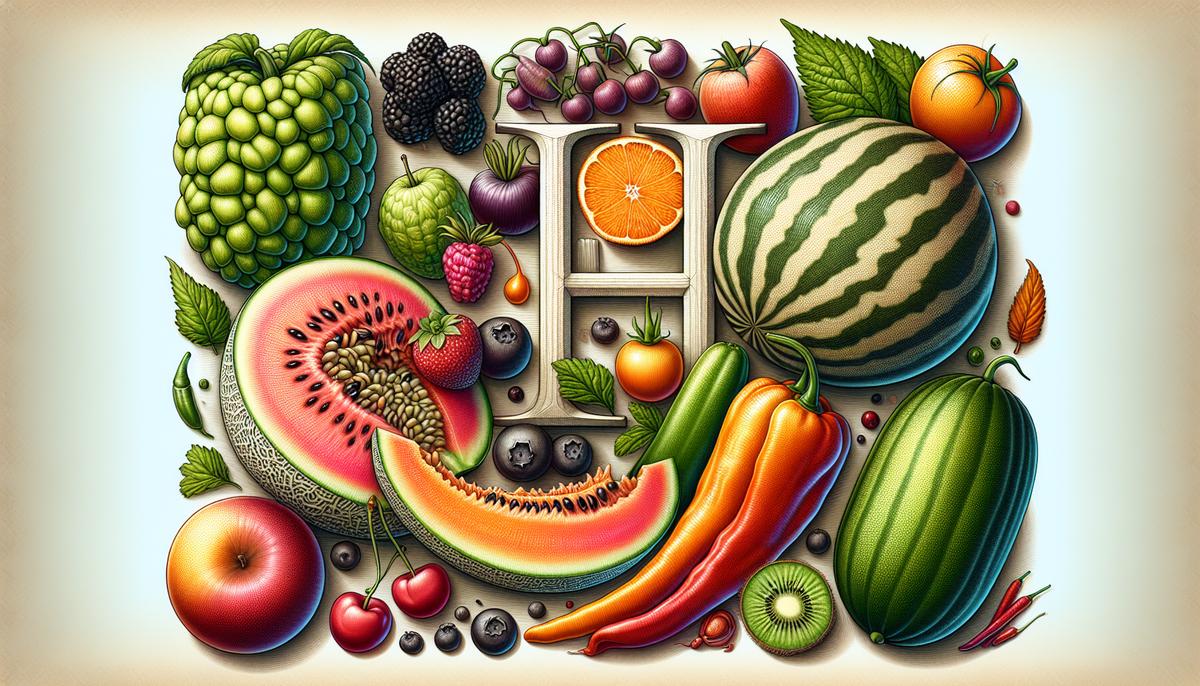Eating a variety of fruits and vegetables is key to a healthy diet, and exploring those that start with the letter “H” can add some delightful surprises to your meals. From sweet and tangy to spicy and savory, each of these foods brings unique flavors and nutritional benefits to the table. Whether you’re looking to add more vitamins to your diet, trying out new recipes, or simply expanding your culinary repertoire, these “H” foods are worth considering. Let’s explore the flavors, health benefits, and culinary uses of fruits and vegetables that start with “H.”
Fruits that start with H
Hazelnuts (Filberts)
Hazelnuts, also known as filberts, are small, round nuts with a sweet, slightly earthy flavor. They are often found in desserts, confectioneries, and as a popular flavoring in coffee and spreads. Native to Europe and Asia, hazelnuts have been enjoyed for centuries and are now cultivated in various parts of the world, including the United States and Turkey.
These nuts are a powerhouse of nutrition, rich in healthy fats, particularly monounsaturated fats, which are beneficial for heart health. They are also a good source of vitamin E, which is an antioxidant that helps protect your cells from damage. Additionally, hazelnuts provide magnesium, calcium, and fiber, contributing to bone health and digestive wellness.
In the kitchen, hazelnuts can be used in a myriad of ways. They can be chopped and added to salads for a crunchy texture, ground into a paste to make hazelnut butter, or incorporated into baked goods like cookies, cakes, and pastries. Roasting hazelnuts enhances their flavor, making them an excellent addition to savory dishes like roasted vegetables or as a topping for creamy soups.
Honeycrisp Apples
Honeycrisp apples are known for their explosive crunch and perfectly balanced sweetness with a hint of tartness. Developed by the University of Minnesota in the 1960s, this apple variety has quickly become a favorite among consumers and chefs alike for its exceptional taste and texture.
Nutritionally, Honeycrisp apples are a great choice for a healthy snack. They are low in calories and high in dietary fiber, which aids in digestion and helps you feel full longer. These apples are also a good source of vitamin C, which supports your immune system and skin health. Additionally, the natural sugars in Honeycrisp apples provide a quick energy boost, making them an ideal pre-workout snack.
Culinary uses for Honeycrisp apples are extensive. They can be eaten fresh, sliced into salads, or paired with cheese for a delightful snack. Their firm texture makes them perfect for baking, whether in pies, crisps, or tarts. For a simple yet delicious treat, try caramelizing Honeycrisp apple slices with a touch of cinnamon and serving them over yogurt or oatmeal.
Honeydew Melon
Honeydew melon is a juicy, sweet fruit with a smooth, pale green flesh and a light green rind. Often enjoyed in fruit salads or as a refreshing snack, honeydew is known for its high water content, which makes it incredibly hydrating, especially during hot summer months.
This melon is packed with essential nutrients, including vitamin C and potassium. Vitamin C is vital for immune function and skin health, while potassium helps maintain proper fluid balance and supports heart health. Honeydew melon is also low in calories, making it a perfect choice for those looking to maintain or lose weight without sacrificing flavor.
In the kitchen, honeydew melon is versatile and easy to incorporate into various dishes. It can be cubed and added to fruit salads, blended into smoothies, or paired with prosciutto for a sweet and savory appetizer. For a unique twist, try making a chilled honeydew soup with a hint of mint and lime, or add honeydew cubes to a refreshing summer cocktail.
Huckleberry
Huckleberries are small, dark berries that are similar in appearance to blueberries but with a more intense, tart flavor. They grow wild in the mountainous regions of North America and are often harvested in the late summer and early fall. Huckleberries are prized for their unique taste and are a favorite ingredient in various regional dishes.
These berries are packed with antioxidants, particularly anthocyanins, which give them their deep color and help protect your cells from oxidative stress. Huckleberries are also a good source of vitamin C and fiber, which support immune function and digestive health. Additionally, they contain a range of vitamins and minerals that contribute to overall wellness.
In terms of culinary uses, huckleberries can be enjoyed fresh, though their tartness often leads them to be used in cooking and baking. They make excellent jams, jellies, and syrups, which can be used to top pancakes, waffles, or yogurt. Huckleberries are also fantastic in baked goods like pies, muffins, and scones. For a savory option, consider making a huckleberry sauce to accompany game meats or poultry.
Vegetables that start with H
Hearts of Palm
Hearts of palm are the inner core of certain palm trees and are known for their tender texture and mild, slightly nutty flavor. These vegetable delicacies are often found canned or jarred and are a popular ingredient in salads and gourmet dishes. They are harvested from the center of the palm tree, making them a unique and sustainable food choice when sourced responsibly.
Nutritionally, hearts of palm are low in calories and fat but high in fiber, making them a great addition to a healthy diet. They provide a good amount of protein compared to other vegetables and are rich in vitamins A and C, which are important for immune health and vision. Additionally, they contain essential minerals like potassium, iron, and zinc.
Culinary uses for hearts of palm are varied and delicious. They can be sliced and added to salads for a crunchy texture or used as a substitute for seafood in dishes like vegan ceviche or crab cakes. Hearts of palm can also be grilled or roasted to bring out their natural sweetness and served as a side dish or appetizer. For a creative twist, try incorporating them into pasta dishes or as a topping for pizzas.
Horseradish Root
Horseradish root is a pungent, spicy root vegetable that adds a distinctive kick to dishes. Known for its strong, peppery flavor, horseradish is often used as a condiment in sauces and spreads. The root itself is typically grated and mixed with vinegar to create prepared horseradish, which can then be used to enhance a variety of foods.
Horseradish root is not only flavorful but also packed with health benefits. It contains compounds called glucosinolates, which have been shown to have anti-cancer properties. Horseradish is also rich in antioxidants, which help protect your body from damage caused by free radicals. Additionally, it has antimicrobial properties, making it beneficial for your immune system.
In the kitchen, horseradish can be used in many ways to add zest to your meals. It is a classic accompaniment to roast beef and can be mixed into sauces for an extra kick. Horseradish can also be added to mashed potatoes, mixed into salad dressings, or used to spice up sandwiches and wraps. For a unique twist, try incorporating horseradish into your homemade pickles or coleslaw.
Hubbard Squash
Hubbard squash is a large, hard-shelled winter squash with a sweet, nutty flavor and vibrant orange flesh. This squash variety is known for its impressive size and bumpy, often blue or green skin. It can be stored for several months, making it a great addition to your pantry during the colder months.
Nutritionally, Hubbard squash is a fantastic source of vitamins A and C, which are important for immune function, skin health, and vision. It is also rich in dietary fiber, which supports digestive health and helps you feel full. Additionally, Hubbard squash provides a good amount of potassium and magnesium, which are essential for muscle and nerve function.
In the kitchen, Hubbard squash can be used in a variety of delicious dishes. Its sweet flesh makes it perfect for roasting, which brings out its natural sugars and enhances its flavor. Roasted Hubbard squash can be served as a side dish, added to salads, or pureed into soups. It can also be used in baking, such as in pies, muffins, or bread. For a savory option, try stuffing Hubbard squash with grains, vegetables, and spices for a hearty and satisfying meal.
Hungarian Wax Peppers
Hungarian wax peppers are medium-sized, yellow to red peppers known for their mild to moderately hot flavor. These peppers are often mistaken for banana peppers due to their similar appearance but have a distinct heat that sets them apart. They are commonly used in Hungarian cuisine and are a popular ingredient in pickling and cooking.
These peppers are not only flavorful but also packed with nutrients. They are an excellent source of vitamin C, which supports immune health and skin integrity. Hungarian wax peppers also contain capsaicin, the compound responsible for their heat, which has been shown to have anti-inflammatory and pain-relieving properties. Additionally, they provide vitamins A and B6, which are important for vision and brain health.
In culinary applications, Hungarian wax peppers can be used in a variety of ways. They are perfect for pickling, providing a tangy and slightly spicy addition to sandwiches, salads, and charcuterie boards. These peppers can also be stuffed with cheese, meat, or grains and baked for a delicious appetizer or main dish. Additionally, Hungarian wax peppers can be sliced and added to stir-fries, stews, and sauces to bring a subtle heat and vibrant flavor to your meals.




